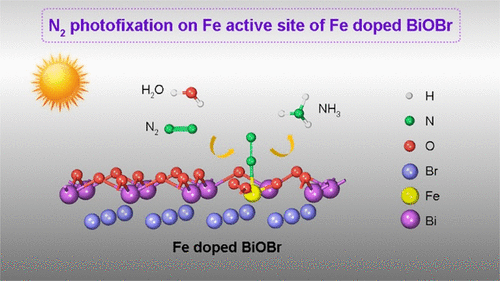当前位置:
X-MOL 学术
›
Chem. Mater.
›
论文详情
Our official English website, www.x-mol.net, welcomes your feedback! (Note: you will need to create a separate account there.)
Fe Enhanced Visible-Light-Driven Nitrogen Fixation on BiOBr Nanosheets
Chemistry of Materials ( IF 8.6 ) Pub Date : 2020-01-17 , DOI: 10.1021/acs.chemmater.9b04448 Yang Liu 1 , Zhuofeng Hu 2 , Jimmy C. Yu 1
Chemistry of Materials ( IF 8.6 ) Pub Date : 2020-01-17 , DOI: 10.1021/acs.chemmater.9b04448 Yang Liu 1 , Zhuofeng Hu 2 , Jimmy C. Yu 1
Affiliation

|
Photocatalytic conversion of nitrogen (N2) to ammonia (NH3) requires strong binding of N2 onto the catalyst surface and the generation of photoexcited electrons to activate the N≡N bond. In this study, Fe is doped into BiOBr nanosheets, where the photoexcited electrons have enough energy to break the N≡N bond. The presence of Fe induces the formation of oxygen vacancies (OVs) in its vicinity, making it a photoexcited electron-rich region. The reduced Fe species effectively donates its available 3d orbital electron into the π N–N antibonding orbital to activate the adsorbed N2. With Fe as the active site, the N2 fixation rate of Fe-doped BiOBr is enhanced by eight times. This work provides a sustainable alternative for N2 photofixation and strategies for the catalyst design.
中文翻译:

Fe增强BiOBr纳米片上的可见光驱动氮固定
氮(N 2)向氨(NH 3)的光催化转化需要N 2与催化剂表面牢固结合,并需要产生光激发电子来激活N≡N键。在这项研究中,将Fe掺杂到BiOBr纳米片中,其中光激发电子具有足够的能量来破坏N≡N键。Fe的存在会在其附近诱导氧空位(OVs)的形成,使其成为光激发电子富集区。还原的铁物种有效地将其可用的3d轨道电子捐献给πN–N反键轨道,以激活吸附的N 2。以Fe为活性位点的N 2掺铁的BiOBr的固着率提高了八倍。这项工作为N 2光固定和催化剂设计策略提供了可持续的选择。
更新日期:2020-01-17
中文翻译:

Fe增强BiOBr纳米片上的可见光驱动氮固定
氮(N 2)向氨(NH 3)的光催化转化需要N 2与催化剂表面牢固结合,并需要产生光激发电子来激活N≡N键。在这项研究中,将Fe掺杂到BiOBr纳米片中,其中光激发电子具有足够的能量来破坏N≡N键。Fe的存在会在其附近诱导氧空位(OVs)的形成,使其成为光激发电子富集区。还原的铁物种有效地将其可用的3d轨道电子捐献给πN–N反键轨道,以激活吸附的N 2。以Fe为活性位点的N 2掺铁的BiOBr的固着率提高了八倍。这项工作为N 2光固定和催化剂设计策略提供了可持续的选择。


























 京公网安备 11010802027423号
京公网安备 11010802027423号